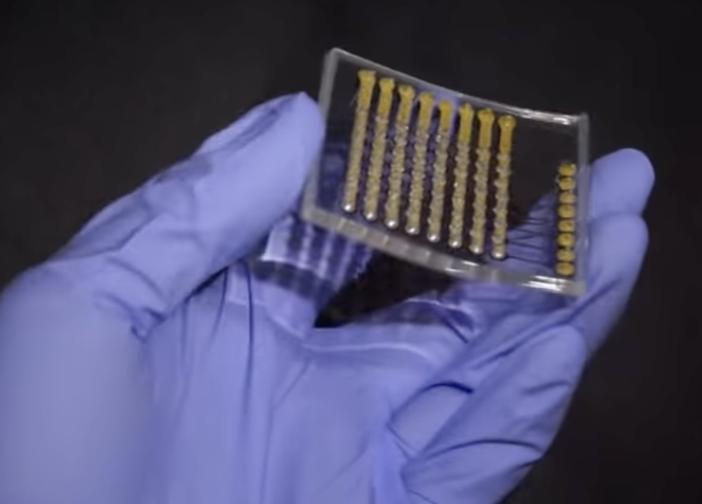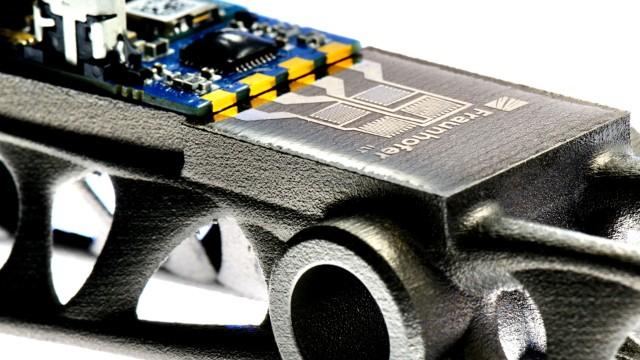
Researchers at the University of Minnesota Twin Cities (UMTC) have developed a fully-3D printed organic light-emitting diode (OLED) display akin to those found in commercial televisions and smartphones.
Built using a custom extrusion 3D printer, fitted with a spray-printing add-on for producing its active layers, the flexible 64-pixel monitor has already proven capable of displaying text and emojis at low-resolution. With further R&D, the team believe the tech behind their malleable monitor could now serve as a low-cost alternative to lab-based OLED production, or even make it possible to create them at home.
“OLED displays are usually produced in big, expensive, ultra-clean fabrication facilities,” said study lead Michael McAlpine. “We wanted to see if we could basically condense all of that down and print an OLED display on our table-top 3D printer, which was custom built and costs about the same as a Tesla Model S.”
Creating cheaper OLEDs at scale
According to the UMTC team, the high contrast ratio, efficiency and mechanical pliability of OLED monitors, make them a competitive alternative to conventional liquid crystal displays (LCDs). In order to add greater affordability and scalability to this long list of benefits, significant research is now being plowed into devising methods of producing them via 3D printing, but previous efforts have faced issues.
For instance, advances in extrusion are increasingly enabling the creation of optoelectronics from conjugated polymers, yet maintaining the stability of junctions between their surface and metal underlayers has proven challenging. Equally, the UMTC engineers have tried to print OLEDs themselves in the past, only to find the non-uniformity of their prototypes’ light emitting layers to be similarly problematic.
To get around these drawbacks, the team has therefore developed a custom 3D printer that uses extrusion to produce top cathode arrays, and a spray nozzle to distribute the inks that form the top layers of devices in a more uniform manner, which has allowed them to make even more headway than they initially expected.
“I thought I would get something, but maybe not a fully working display,” said excited study co-author Ruitao Su, 2020 UNM graduate and postdoctoral researcher at MIT. “But then it turns out all the pixels were working, and I can display the text I designed. My first reaction was ‘It is real!’ I was not able to sleep the whole night.”
The UMTC’s fully-printed display
Essentially composed of six layers printed upon a flexible PET film, the team’s unique OLED display is built from cathodes sitting on a silicone insulation layer, conductive polymer and a bottom set of interconnects. Interestingly, during production, the researchers found that spray-printing their device’s surface provided it with “controllable thicknesses,” while allowing its layers to be “intimately interfaced.”

Once ready, the engineers tested their prototype, complete with anodes and cathodes interconnected along the same columns and rows in an 8 x 8 grid, with each of its pixels functioning perfectly. In fact, the team say their device exhibited a very impressive pixel response time of just 0.2 milliseconds, which is “on the same order of magnitude” as LEDs and “one faster” than typical LCDs.
Additionally, during testing, Su says the team found their display could be encapsulated in other materials too, lending it significant wearable electronics potential. “The device exhibited a relatively stable emission over the 2,000 bending cycles,” explained Su, “suggesting that fully-3D printed OLEDs can potentially be used for important applications in soft electronics and wearable devices.”
When scanned with a current of 10 mA, the team did notice some pixel variation, but they say this can be reduced by minimizing any deviations in its surface layer thickness. Moving forwards, the UMTC crew have now committed to developing higher resolution, improved brightness displays, and in future, they say their approach could also be applied in the creation of photovoltaic or sensing devices.
“The nice part about our research is that the manufacturing is all built in, so we’re not talking 20 years out with some ‘pie in the sky’ vision,” added McAlpine. “This is something that we actually manufactured in the lab, and it is not hard to imagine that you could translate this to printing all kinds of displays ourselves at home or on the go within just a few years, on a small portable printer.”
3D printed electronics’ advances
The electronic 3D printing sector may still be at a relatively early stage of development, but there have been signs of the technology behind it starting to take serious strides towards commercialization. One of the market’s early leaders, Nano Dimension, for instance, has continued to iterate upon its proprietary electronic 3D printing technology, launching its new DragonFly IV machine late last year.
Likewise, nScrypt unveiled its SmartPump microdispensing toolhead in September 2021, which unlocked the ability to 3D print multi-axis electronics onto curved surfaces with its machines. At the time, the firm demoed the part’s capabilities by 3D printing its logo directly onto a computer mouse, leading its CEO Ken Church to describe the add-on’s applications as “game-changing and virtually unlimited.”
Optomec has also seen its conformal printing-capable Aerosol Jet Printing (AJP) machines applied in new areas recently, with a Fortune 50 adopter revealed to be using them to 3D print wearable electronics. Although the identity of the client has yet to be disclosed, the unnamed manufacturer is said to be a repeat customer that’s aiming to deploy them as a means of aiding their ‘march to production.’
The researchers’ findings are detailed in their paper titled “3D-printed flexible organic light-emitting diode displays,” which was co-authored by Ruitao Su, Sung Hyun Park, Song Ih Ahn and Michael C. McAlpine.
To stay up to date with the latest 3D printing news, don’t forget to subscribe to the 3D Printing Industry newsletter or follow us on Twitter or liking our page on Facebook.
For a deeper dive into additive manufacturing, you can now subscribe to our Youtube channel, featuring discussion, debriefs, and shots of 3D printing in-action.
Are you looking for a job in the additive manufacturing industry? Visit 3D Printing Jobs for a selection of roles in the industry.
Featured image shows the UMTC team’s flexible fully-3D printed OLED display. Image via the Science Advances journal.